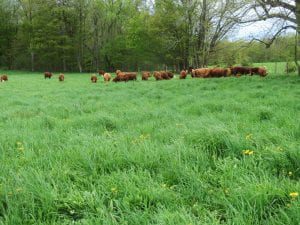The SCNY team is collecting scissor cuts of growing grass fields this spring to provide information about quality changes over time for dairy farmers, as well as provide information to livestock farmers who may harvest feed at different qualities to feed to different livestock classes. I’ll provide updates over the next few weeks for fields across the CNY region, including updates from other locations around the state as they’re available.
In general, grass fields can be thought of as very lush early on, with high levels of Total Digestible Nutrients (TDN) (a number made up of digestible fiber, protein, fat, and carbohydrates), which is commonly used for determining the quality of livestock forages. As the season progresses, those numbers will typically fall as a percent of total, while the undigestible portion of the plant will increase (uNDF).
Information I’ll share will show the specific nutrients for the samples harvested by scissor cut this week. Most of these samples were taken in Cortland County. Over the next few weeks, I’ll add a graph to show the changes over time for each of those nutrients.
This week’s scissor cut analysis
Scissor cuts were taken this week at three fields on Wednesday, May 15th. Farm 3 had a Nitrogen application along with manure application, while farms 1 & 2 utilized manure application only.
NDF levels for these three fields averaged 57.1, and were fairly tight. NDFD30 levels averaged 67.0, ranging from 66 – 72; uNDF240 levels averaged 10.5, ranging from 7.9-11.8.
Overall TDN numbers averaged 65.7, ranging from 64-68, still firmly in excellent levels for grass harvest for high quality. For more on TDN and livestock, see the end of the article.

Explanation of NDF Goals & TDN Goals for Beef Cattle Forage, courtesy of CCE Delaware County Team
Table of Nutrient Levels from Scissor Cuts Taken on 5/15/24:
| Available Protein | ADF | NDF | TDN | NDFD30 | uNDF240 | |
| Farm 1 | 17.9 | 28.4 | 57.1 | 64 | 72 | 7.9 |
| Farm 2 | 16.8 | 32.8 | 58 | 65 | 62.9 | 11.8 |
| Farm 3 | 21.8 | 30.1 | 56.2 | 68 | 66.1 | 11.8 |
| Average | 18.8 | 30.4 | 57.1 | 65.7 | 67.0 | 10.5 |
Delaware County CCE Updates
The CCE Delaware Team does an expansive scissor cut analysis each spring. Their latest update can be found at: https://www.ccedelaware.org/2024/05/17/forage-quality-scissors-cut-results-may-14-2024/. They have a great system for updating timeliness of forage harvest for different classes of livestock – check out their posts for more information.
Utilizing Scissor Cuts and Forage Reports
Information presented weekly during this time informs timely cutting of forages to help allocate targeted quality feedstuffs to specific classes of livestock. Farmers can use this information to harvest a bulk of forage at a set time period for winter forage feed-out based on the needs of a specific class of livestock they’re raising.
TDN and Targeting Forage for Specific Livestock Classes
Forage TDN can be grouped into three categories of “quality”. Low TDN content is typically under 52% TDN, average 52-59%, and high quality forage greater than 59% TDN.
In simple terms, TDN is all the stuff in the plant cell that the cow can use for nutritional needs and provides a basis for comparison across different forages. It’s also a good comparison method for mostly-forage based diets. And for those who sample forages for nutritional analysis, it’s a number listed on a forage report.
Beef Cows & Requirements
Lactating beef cows, in comparison to beef cows not nursing, require more TDN nutrients – typically in the higher 50’s to low 60’s – to provide adequate nutrients for the demands of lactation and reproduction. As production increases, the amount of TDN increases.
- An 1100lb cow producing 20 pounds of peak milk requires 58% TDN, while a cow producing 10 pounds of peak milk requires only 54% TDN.
- Conversely, if a cow has requirements of 58% and only 54% is provided, she will either be limited on milk production, or use body reserves to supply milk, or both.
TDN for a Growing or Finishing Animal
The amount of average daily gain (ADG) a growing or finishing animal achieves is correlated with the amount of TDN that animal consumes.
- A 300 lb calf (finishing weight of 1100 lb) only fed a diet with 59% TDN will only achieve 1 lb of gain/day.
- Supplying 75% of dry matter as TDN will achieve 3 lb/day gain.
Simply, the more TDN supplied, the greater the amount of gain achieved.
This holds true with a heavier steer, although the amount of TDN needed to achieve higher ADG is not as high.
- A diet fed to a 800 lb steer with 60% of dry matter as TDN will supply 2 lb of gain.
- 70% TDN gets to 2.9 lb ADG.
Again, thinking about the feed offered to the steer – if we need a steer to gain 2.5 lb/day to get to finish weight on time, will we need to supplement our 57% TDN hay with other grains to achieve a diet that will finish that steer?
Knowing cattle inventory for the winter ahead of time – ie, how many head of brood cows vs replacement heifers vs growing steers vs finishing steers – will help determine how much feed to put up of which quality. To get assistance with this inventory planning, feel free to reach out! We have worksheets to help you work through this exercise!

